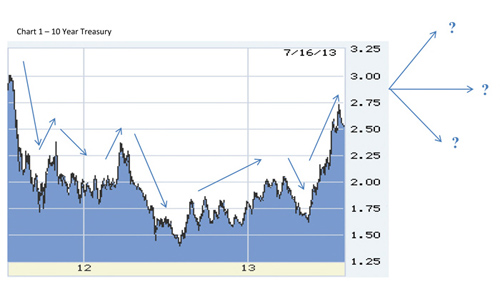Rising rates—Are we there yet?
From back seat or driver's seat, everyone wonders
- |
- Written by ALCO Beat
 One of my favorite childhood memories is the annual family summer vacation at the lake. Barbeques, swimming, fishing, family, and friends, what's not to love?
One of my favorite childhood memories is the annual family summer vacation at the lake. Barbeques, swimming, fishing, family, and friends, what's not to love?
By Keith Reagan, Darling Consulting Group
For me, the answer to that was, the drive to the lake.
We did not have iPods, iPads, satellite radio, nor built-in personal DVD players.
We had license-plate games, a couple of radio stations (mostly static), and a station wagon with a bench seat and no air conditioning (not an SUV with air conditioned captain's chairs).
The anticipation and excitement of the upcoming vacation would soon give way to being hot and uncomfortable, fighting with my siblings. And all of us asking:
Are we there yet?
Over the last couple of years, bankers have been asking the same question: Are we there yet?
Front seat, back seat, question's the same
Of course, they aren't worried about getting a swim in. They are wondering about rising rates, with every bond market sell-off. So far, there has been an ensuing rally following each sell-off, as illustrated in the chart below.

Clearly there were additional forces that caused the most recent sell-off (thank you Federal Open Market Committee).
Will this sell-off give way to an eventual rally as it has the last couple of years, or is this the inevitable start of rising rates?
Unfortunately, no one knows the answer to that. Fortunately, however, predicting interest rates is not what A/L management is all about.
Therefore, the answer my father gave me to the incessant "Are we there yet?" questions-"Please stop asking me that (although he didn't always say please and as the trip went along there were also threats that went along with the answer)"--applies to banks today.
Instead of asking "Are we there yet?" then, please make sure you are asking the following question:
Q. Is my bank exposed to rising rates?
A. If your bank's answer is "yes," preparing for a rise in rates is critical. If it's "no," then does it matter if we are there yet? (It still matters--but for different reasons)
Given the trend seen in the chart and the potential for that to continue, should your bank extend assets or extend liabilities?
Yes, because it depends entirely on your asset/liability position.
Use your ALCO process
Your ALCO process should work as a road map. Is your bank exposed to rising rates, or falling rates (or both)? What about current rates?
Depending upon the answers to these questions, your ALCO road map should lead you in the proper direction. Remember, however, depending on who is in the car with you (ALCO, board members, regulators, etc.) be prepared to answer "Are we there yet?" with every twist and turn.
Chances are net interest income simulations look significantly better this quarter versus recent quarters, given the additional steepness in the yield curve.
Is the projected improvement real?
It is if loan rates have truly increased along with market rates. If they have not, actual NII could be significantly lower than model projections suggest. Discussion of this issue should be a priority at ALCO!
Even with likely improvement this quarter, industrywide projections depict bank earnings being exposed to the current interest rate environment and to an environment where rates decline further, while becoming more and more liability sensitive (or less and less asset sensitive) each day.
Loan demand is sparse. Loan competition is immense--many competitors have not increased loan rates recently, further intensifying the competition. Expenses are increasing, and fee income is coming under increasing pressure and scrutiny. These issues, along with the uncertainty/volatility of the yield curve, will pressure earnings.
Steps your bank can take
There is no one-size-fits-all solution to balance sheet management. On top of different interest rate risk positions, some banks are growing while others are shrinking; some banks are selling while others are buying. Nonetheless, there are strategies all banks can employ to help reach their desired goals:
• Chop rates all the way. Continue to lower deposit rates, even though long-term market rates have increased. Short-term market rates have not increased. It is well past the time to flush out any remaining rate-sensitive deposits.
• Look longer on loan side. Consider the risk/return of adding longer-term loans to your portfolio. Offer seven- to ten-year loans if five-year loan rates are too competitive. For the right credits, you may be able to enhance margin and improve credit spreads.
Interest rate risk is preferable to increased credit risk.
• Also, look shorter on the loan side. Added yield curve steepness may make longer-term loans too expensive for your customer, so consider being even more aggressive than your competitors but shorten the term of the loan.
Do not accept too low a rate and interest rate risk. (Implementing a back-to-back swap program would accomplish a similar goal and increase non-interest income).
• Use an index for quotes. If you are not already doing so, quote a spread over an index, not a rate, to your loan applicants. This will help mitigate some of the volatility risk associated with the current interest rate markets. How much money was left on the table in the last quarter alone?
• Try something special. Consider loan types and aggressively target those loan customers versus buying bonds today. Programs that have worked in different parts of the country include:
• Ten-year residential specials
• Home equity specials (fixed and floating)
• Jumbo loan programs
• Aggressive ARMs (Yes, some borrowers still like ARMs)
• Don't get cherry-picked. Ensure the entire relationship is acquired with all loan programs. Deposit relationships may not be "worth" what they used to be, but they will be again.
• Don't give stuff away. Make sure options included in a deal are priced appropriately (the value of rate locks, caps, floors, etc. have soared along with interest rates).
• Include prepayment penalties. Protect yourself. Rates could go lower.
• Consider loan purchases. Not every loan outside your lending area is a bad loan. There is due diligence necessary but there are good opportunities available.
These general strategies should added to specific balance sheet strategies (i.e. pre-investment, leverage, asset and liability extension (on-balance sheet or by using derivatives), wholesale restructuring, etc.) to ensure optimal earnings performance while balancing the multitude of risks facing your institution and the industry as a whole.
Increased market volatility causes good decisions to be more difficult and bad decisions to be more harmful. Balancing the risk/return of strategic action (or inaction) to ensure optimal performance is ALCO's primary objective!
Make the most of ALCO meetings
Every one of your ALCO meetings should be a mini strategic planning session, blending peripheral discussion on local and national economic developments with focused short-term tactical and longer-term strategic efforts to improve earnings while managing liquidity, interest rate risk and capital.
Over the last few years, there were plenty of banks that answered "Yes, we are there," and rates were going to keep rising, yet they did not.
As rates are rising, it is a good time for asset-sensitive banks to protect against falling rates.
As rates are declining it is a good time for liability-sensitive banks to protect against rates rising.
But strategic action based on a rate forecast, directly or indirectly is never a good idea. (Some A/L models have a built-in forecast. Does yours?)
The trends seen recently may continue, they may not (I can make an argument to defend either point of view). Reaching your strategic goals should not be dependent either way.
The conclusion in all this: My family and I always reached the lake and my parents could finally answer, "Yes, we are there."
We will eventually reach a rising rate environment, and your ALCO should be preparing for it--whether you are exposed to it or poised to benefit from it.
About the author
Keith Reagan is a managing director at Darling Consulting Group. He has nearly 20 years of experience working directly with community banks, helping them improve their overall performance through proactive management of liquidity, interest rate risk, and capital. He works to develop strategies that best fit the risk/return dynamics of their balance sheets. Keith has served on the faculty of ABA's Stonier School of Banking, has written many articles for a variety of professional publications, and is the editor of DCG's monthly periodical, the DCG Bulletin.
Tagged under Management, Financial Trends, Risk Management, ALCO, ALCO Beat, Rate Risk,














